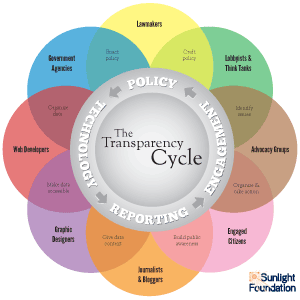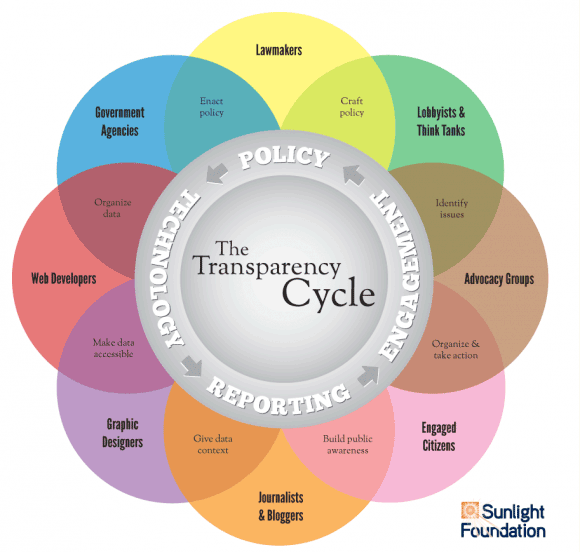Introducing the Cycle of Transparency
Government transparency is that rarest of political phenomena — a great idea with support across the political spectrum and popularity among the public. Yet, here we are in the 21st century with every tool we would need to make government more transparent and accountable, and still we are operating with a government that often behaves as it did in the 19th century.
So, transparent government is a good thing, but we do not yet have one. Now what?
It’s clear that there is a breakdown between conceptual support for the idea of government transparency and enacting the changes necessary to make it so. There is fear and resistance to change inside government that requires cultural, political, and attitude adjustments. And there’s a large gap between the good intentions of citizens and watchdog groups and think tanks and reporters, and translating those good intentions into effective results. Many people want to act, but they rarely know how or where to begin.
For many, the concept of transparency still simply feels too vague to get behind in a meaningful way. People strongly support transparency in theory, but don’t know what they would need to do, or how they would need to think, to create the “open, transparent government” we talk about.
We’ve grappled with these challenges at Sunlight since our founding four years ago, and have been thinking about it with increased urgency over the last year in particular. How do we connect all the necessary parties and resources, and how do we put them together and act on them in the right way to actually make government more open and transparent?
Perhaps even more challenging: how do we explain it to people in a way that helps them know where they fit?
Now, the pieces are falling into place.
We know that at the heart of the open, transparent government we seek is ‘open’ government data that is available online and in real-time.
Government information should be as accessible to us as information about the weather, sports scores or knowing what’s going on in the stock market — and we need it to be this way so we can both hold government accountable and create new enterprise with what is made available to us.
In order to reach our vision of an open government – or an online, real-time government – we also know there are a number of “things” that must occur – and not just occur once, but continue to happen over time and continuously reinforce each other along the way.
This “Cycle of Transparency” demonstrates, in one image, the specific actions and the variety of actors that need to work together to create the open, transparent government we seek. We hope this graphic can be a useful tool in thinking about how to make city, state, federal, and even international governments more transparent.
Each type of actor and action complements the others in the Cycle to make every other element easier, or even possible at all. Of great importance is that just about anyone – from hardcore Internet developers to academics to government staff to reporters to activists – has a place in it.
One of the first places we often start in talking about transparency is in the crafting of policies that require the release of data from government. While no one piece of this Cycle is “first” or more important than others, the legislative component is a useful starting point. (Mostly because it’s the first one we wrote down.)
Lawmakers, lobbyists and think tanks (as well as citizens) all play a role in articulating new transparency policies and pushing them through the twists and turns of government processes. Those policies must adhere to core principles of openness, such as making sure government data is “raw,” that it is complete, or that it is searchable (in total, there are nine of these openness principles that government data should adhere to).
These principles aren’t things that government is accustomed to just yet, so the advocacy process is pretty difficult, and the subsequent “gap” between writing new legislation and actually getting legislation passed is more like a “chasm.”
One of the beautiful aspects of open government, however, is that while laws are written (and should be passed) to require the release of government data, Congress, federal agencies, states and cities can – in most cases – become more open and transparent without new laws.
Sidenote: A great example of “enacting without law” is that no law has been passed requiring all federal legislation to be available online for 72 hours before it is debated by Congress. Yet in 2009, Congress showed again and again that it could post bills online for three days before debate without the law requiring that action. Similarly, the “Open Government Directive,” released in a memo by the White House, has made all kinds of new government data available without laws to require it. (Though, it would be ideal if Congress codified the Directive into law to give it a lasting impact.)
Once data is released, government agencies (such as the Department of Energy or Transportation) and web developers anywhere can build the necessary technology to organize the data and make it usable. Federal repositories like Data.gov or Sunlight’s National Data Catalog are great examples of this type of public/private foundation building.
In the way of analogy, one way to think about this entire process is that it turns government into a type of public data wholesaler through which the public can build retail outlets.
With data being made easily accessible, journalists and bloggers can begin to dig into it, mix it up, identify relevant information and give the data context. As that critical context is provided, citizens absorb it and spread the information to others – both online and face-to-face – and make the data actionable.
Ultimately, informed citizen action creates greater public awareness; citizens become more effective, responsible advocates; holding government accountable becomes informed by data rather than inside-the-Beltway pundits, and better decisions can be made for our democracy.
As each element of the Cycle of Transparency moves forward concurrently, bringing about the changes we need to create a more transparent government, we also identify new needs.
At the end of the day, the process that the Cycle of Transparency describes is about creating a government more deserving of our trust, and ultimately, a government that allows its citizens to fully participate and hold government accountable as our Founders intended.



